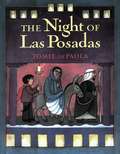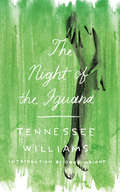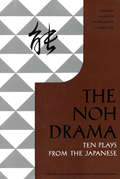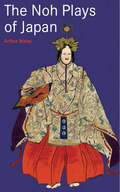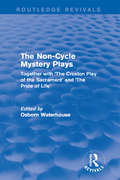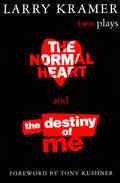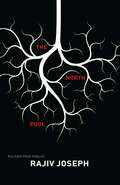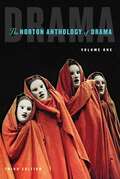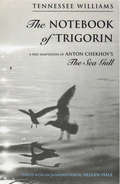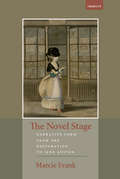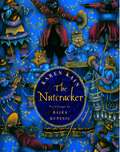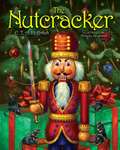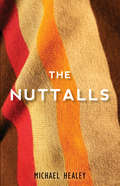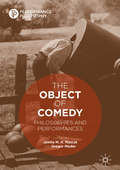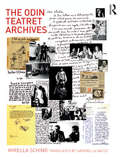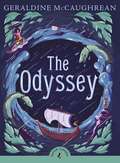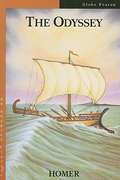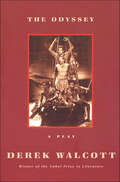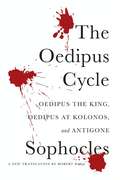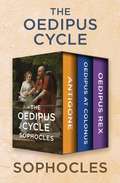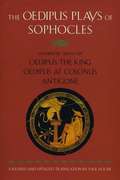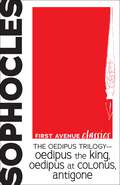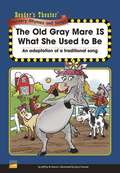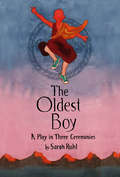- Table View
- List View
The Night of Las Posadas
by Tomie DepaolaChristmas Eve in Santa Fe is celebrated by the traditional procession Las Posadas. Sister Angie arranges for the people of a nearby mountain village to re-enact Mary and Joseph's search for shelter the night baby Jesus was born. This year was going to be extra special. Sister Angie's niece, Lupe, and Lupe's husband, Roberto, were to play the part of Mary and Joseph. The whole village had been practicing for weeks. Everything was going to be perfect. But when sister Angie becomes sick and Lupe and Roberto get stuck in a snowstorm, only a miracle can save Las Posadas.
The Night of the Iguana
by Tennessee Williams Doug WrightNow published for the first time as a trade paperback with a new introduction and the short story on which it was based. Williams wrote: "This is a play about love in its purest terms." It is also Williams's robust and persuasive plea for endurance and resistance in the face of human suffering. The earthy widow Maxine Faulk is proprietress of a rundown hotel at the edge of a Mexican cliff overlooking the Pacific Ocean where the defrocked Rev. Shannon, his tour group of ladies from a West Texas women's college, the self-described New England spinster Hannah Jelkes and her ninety-seven-year-old grandfather, Jonathan Coffin ("the world's oldest living and practicing poet"), a family of grotesque Nazi vacationers, and an iguana tied by its throat to the veranda, all find themselves assembled for a rainy and turbulent night. This is the first trade paperback edition of The Night of the Iguana and comes with an Introduction by award-winning playwright Doug Wright, the author's original Foreword, the short story "The Night of the Iguana" which was the germ for the play, plus an essay by noted Tennessee Williams scholar, Kenneth Holditch. "I'm tired of conducting services in praise and worship of a senile delinquent--yeah, that's what I said, I shouted! All your Western theologies, the whole mythology of them, are based on the concept of God as a senile delinquent and, by God, I will not and cannot continue to conduct services in praise and worship of this...this...this angry, petulant old man." --The Rev. T. Lawrence Shannon, from The Night of the Iguana
The Noh Drama: Ten Plays from the Japanese (Unesco collection of representative works)
by Noh CommitteeThis classic of Japanese studies presents extensive information about the history, culture and practice of Noh drama--one of Japan's most treasured dramatic art forms.<P><P>Noh as an independent and original art form--ultimately destined to supersede the earlier Dengaku, Sarugaku and other song dances--incorporates the most significant elements of the former and especially of the Kusemai (tune dance).With it a new literary form may be said to have been created.The invention of Noh is attributed to Kwannami Kiyotsugu (1333-1384), a distinguished actor and writer of Sarugaku and to his son Zeami Motokiyo (1363-1443), who developed and refined the art under the patronage of Yoshimitsu, the third Ashikaga shogun. In addition to his dramatic activities, Zeami composed a number of works, the most important of which is called the Kwadensho (the Book of the Flower), or more properly, Fushi-kwadensho which he explained the nature and aesthetic principles governing Noh plays, and gave detailed instructions concerning the manner of composition, acting, direction, and production of these dramas.Combining the elements of dance, miming, music, and chants, Noh plays may be described as lyrico-dramatic tone-poems, in which the text has a function somewhat similar to that of the libretto in a Wagner or Debussy opera.
The Noh Plays of Japan
by Arthur WaleyFirst published in 1921, The Noh Plays of Japan has been justly famous for more than three-quarters of a century and established the Noh play for the Western reader as beautiful literature. It contains translations of nineteen plays and summaries of sixteen more.
The Noh Plays of Japan
by Arthur WaleyFirst published in 1921, The Noh Plays of Japan has been justly famous for more than three-quarters of a century and established the Noh play for the Western reader as beautiful literature. It contains translations of nineteen plays and summaries of sixteen more.
The Non-Cycle Mystery Plays: Together with 'The Croxton Play of the Sacrament' and 'The Pride of Life' (Routledge Revivals)
by Osborn WaterhouseBetween the beginning of the tenth and the end of the sixteenth centuries, in all parts of Great Britain from Aberdeen to Cornwall, performances of liturgical and mystery plays are on record. This book, first published in 1909, is a collection of early-English religious plays with a detailed introduction written by the editor Osborn Waterhouse. The Non-Cycle Mystery Plays will be of interest to students of drama, performance and theatre studies.
The Normal Heart and The Destiny of Me: Two Plays
by Larry Kramer Tony KushnerThe Normal Heart, set during the early years of the AIDS epidemic, is the impassioned indictment of a society that allowed the plague to happen, a moving denunciation of the ignorance and fear that helped kill an entire generation. It has been produced and taught all over the world. Its companion play, The Destiny of Me is the stirring story of an AIDS activist forced to put his life in the hands of the very doctor he has been denouncing.
The North Pool
by Rajiv JosephKhadim has no idea why he's been called into the office of Dr. Danielson, the Vice Principal at Sheffield High. At first, Danielson is cagey, using a minor violation to keep the boy at school for detention. But as tension mounts, Danielson alternately plays good cop and bad, and winds up catching Khadim in a series of lies about crimes he may (or may not) have committed.The truth shifts constantly in this riveting cat-and-mouse thriller from Pulitzer Prize finalist Rajiv Joseph. What's bothering Dr. Danielson? What are the secrets that trouble Khadim? As the semester reaches its final hour, the time for revelation begins. The North Pool is a psychological drama that weaves a timely character study about racial and cultural profiling in America, skillfully using an interrogation to peel away ever more unexpected layers of the characters' lives as they navigate our increasingly complex society.
The Norton Anthology of Drama
by J. Ellen Gainor Martin Puchner Stanton B. GarnerComprehensive and up-to-date, now with more instructor resources <p><p>Choose from the most comprehensive collection of plays. Enjoy accessible apparatus that helps students better analyze the works. Savor an eye-catching and informative illustration program focusing on performance.
The Notebook of Trigorin: A Free Adaptation of Chechkov's The Sea Gull
by Tennessee Williams Allean HaleTennessee Williams freely adapts Anton Chekhov's Russian classic "The Seagull". From the master twentieth-century playwright Tennessee Williams-an adaptation of Chekhov's The Sea Gull, never before available to the general trade. The Notebook of Trigorin is faithful to Chekhov's story of longing and unrequited love. Set on a provincial Russian Estate, its peaceful environs offer stark contrast to the turbulent lives of its characters. Constantine, a young writer, must compete for the attention of his mother, a self-obsessed, often comical aging actress, Madame Arkadina, and his romantic ideal, Nina. His rival for both women is Trigorin, an established author bound to Arkadina by her patronage of his work, and attracted to Nina by her beauty. Trigorin cannot keep himself from consuming everything of value in Constantine's life. Only in the final scenes do all discover that the price for love and fragility can be horribly high. But if the words in The Notebook of Trigorin are essentially Chekhov's, the voice belongs firmly to Tennessee Williams. The dialogue resonates with echoes of the themes Williams developed as his signatures-compassion for the artistic soul and its vulnerability in the face of the world's "successfully practiced duplicity" (Act I).
The Novel Stage: Narrative Form from the Restoration to Jane Austen (Transits: Literature, Thought & Culture 1650-1850)
by Marcie FrankMarcie Frank’s study traces the migration of tragicomedy, the comedy of manners, and melodrama from the stage to the novel, offering a dramatic new approach to the history of the English novel that examines how the collaboration of genres contributed to the novel’s narrative form and to the modern organization of literature. Drawing on media theory and focusing on the less-examined narrative contributions of such authors as Aphra Behn, Frances Burney, and Elizabeth Inchbald, alongside those of Samuel Richardson, Henry Fielding, and Jane Austen, The Novel Stage tells the story of the novel as it was shaped by the stage. Published by Bucknell University Press. Distributed worldwide by Rutgers University Press.
The Nutcracker
by Karen KainMisha and Marie are thrilled that Christmas is coming. It’s a frosty night, the neighbors are all invited, and Peter the stable boy is sweeping the barn in preparation for the dancing to come. But there’s a disappointment in store. Instead of the beautiful doll she’d hoped for, the only thing strange old Uncle Nikolai has for Marie is a wooden nutcracker. Marie thinks it’s a wonderful gift. Little does she know that it will lead her and her brother on the adventure of a lifetime.When Misha and Marie finally go to bed on Christmas Eve, they sleep fitfully and are beset by nightmares. In one particularly bad dream, they join forces — unusual for the squabbling children — and conquer an army that might harm the nutcracker. Their reward is splendid: they are swept to the realm of the Snow Queen for a night of wonders.James Kudelka, the Artistic Director of the National Ballet of Canada, is one of North America’s foremost dance artists. His vision of The Nutcracker is elegantly told by Karen Kain and beautifully rendered by artist Rajka Kupesic, herself a ballet dancer.
The Nutcracker: The Original Holiday Classic
by E. T. HoffmanOn Christmas Eve, seven-year-old Marie and her eight-year-old brother Fritz anxiously await their Christmas gifts. When their godfather—a clock builder and toymaker—arrives, he unveils an ornate clockwork castle adorned with whirling figurines for the children. While Fritz plays with the clock, Marie is taken aside and given another gift—a nutcracker. After Fritz grabs the nutcracker from Marie and breaks its jaw by cracking too many nuts, their playtime ends and they head off to bed. When the clock strikes twelve, magic makes its way into this enduring tale and an epic battle ensues. This timeless classic, featuring all-new full-color and black-and-white illustrations by artist Arkady Roytman and abridged text by Gina Gold, is the perfect story to get anyone in the holiday spirit!
The Nuttalls
by Michael HealeyLiving in relative seclusion, Ev and Ec rely on the kindness of strangers as they struggle with their own internal and external problems. Ev not only suffers from agoraphobia, she believes she is dying from a fatal degenerative disease. Ec, who is obsessed with his eleventh toe (which he has named Toto), is grieving over his estranged fiancée who left him at the altar. Although Ev declares that hell hath no fury like a mother's love, the Nuttalls prove that sometimes family can be your worst enemy.
The Object of Comedy: Philosophies and Performances (Performance Philosophy)
by Jamila M. H. Mascat Gregor ModerWhat is the object of comedy? What makes us laugh and why? Is comedy subversive, restorative or reparative? What is at stake politically, socially and metaphysically when it comes to comedic performances? This book investigates not only the object of comedy but also its objectives – both its deliberate goals and its unintended side effects.In researching the object of comedy, the contributions gathered here encounter comedy as a philosophical object: instead of approaching comedy as a genre, the book engages with it as a language, a medium, an artifice, a weapon, a puzzle or a trouble, a vocation and a repetition. Thus philosophy meets comedy at the intersection of various fields (e.g. psychoanalysis, film studies, cultural studies, and performance studies) –regions that comical practices and theories in fact already traverse.
The Odin Teatret Archives
by Mirella SchinoThe Odin Teatret Archives presents collections from the archives of one of the foremost reference points in global theatre. Letters, notes, work diaries, articles, and a wealth of photographs all chart the daily activity that underpins the life of Odin Teatret, telling the adventurous, complex stories which have produced the pioneering work that defines Odin's laboratory approach to theatre. Odin Teatret have been at the forefront of theatrical innovation for over fifty years, devising new strategies for actor training, knowledge sharing, performance making, theatrical alliances, and ways of creating and encountering audiences. Their extraordinary work has pushed boundaries between Western and Eastern theatre; between process and performance; and between different theatre networks across the world. In this unique volume, Mirella Schino brings together a never before seen collection of source materials which reveal the social, political, and artistic questions facing not just one groundbreaking company, but everyone who tries to make a life in the theatre.
The Odyssey
by Homer Geraldine MccaughreanThis book describes the epic journey of Odysseus, the hero of Ancient Greece...After ten years of war, Odysseus turns his back on Troy and sets sail for home. But his voyage takes another ten years and he must face many dangers - Polyphemus the greedy one-eyed giant, Scylla the six-headed sea monster and even the wrath of the gods themselves - before he is reunited with his wife and son.
The Odyssey of Homer ( An Adapted Classic)
by Homer Henry I. ChristHomer's great epic describes the many adventures of Odysseus, Greek warrior, as he strives over many years to return to his home island of Ithaca after the Trojan War. His colorful adventures, his endurance, his love for his wife and son have the same power to move and inspire readers today as they did in Archaic Greece, 2800 years ago.
The Odyssey: A Play
by Derek WalcottWith its inspired counterpointing of Homeric and Caribbean themes, Derek Walcott's play The Odyssey, commissioned by Britain's Royal Shakespeare Company, springs from the same imaginative sources as his epic poem Omeros."[The Odyssey features Walcott's] voluptuous metaphor making and severe truth telling."--TimeEpisodes of the story of Odysseus' protracted wanderings from fallen Troy to his island home of Ithaca are pungently interspersed with a commentary by the blind singer Billy Blue. Proteus, the Old Man of the Sea, the giant Cyclops, Circe and her revelers, ghosts, and mermaids are among the cast. With its vast sweep and richly figurative language, The Odyssey confirms that Derek Walcott is as compelling a playwright as he is a poet.
The Oedipus Cycle
by SophoclesThe most celebrated plays of ancient Athens in vibrant new translations by award-winning poet Robert Bagg Sophocles' three great masterpieces, gathered here in one volume, dramatize the inexplicable animosity directed at three generations of Thebes' royal family by Apollo, the inscrutable god who terrifies and deceives his victims into acts of incest, betrayal, and kin murder. These fifth-century BCE family dramas--Oedipus the King, Oedipus at Kolonos, and Antigone--are fraught with horrific crises, confrontations, and excruciating choices, all of which still rivet theatergoers and readers in the twenty-first century. Bagg's translations are modern in idiom while faithful to the Greek. They preserve the complexity of Sophocles' characters and their dialogue (whether searingly raw, subtly inflected, or infused with humor) and render Sophocles' choral odes in resonant poetry. The three plays of The Oedipus Cycle, already proven stageworthy, refresh and clarify Sophocles' narratives for a new generation about to discover timeless sources of pleasure and illumination in classical Greek drama. [This text is listed as an example that meets Common Core Standards in English language arts in grades 9-10 at http://www.corestandards.org.]
The Oedipus Cycle: Antigone, Oedipus at Colonus, and Oedipus Rex (The Oedipus Cycle #1)
by SophoclesThe doomed king of Thebes brings shame on his family in this iconic three-play cycle of ancient Greek literature, a foundational work of Western drama. Oedipus Rex: As a young man, Oedipus was told of a prophecy that he would kill his father and marry his mother. Fleeing his home to escape his destiny, he becomes the king of Thebes by marrying the former king&’s widow. But now Thebes is cursed until Oedipus discovers who killed his predecessor—a mystery that will lead him to his own doom. Oedipus at Colonus: Blind and exiled from his own country, Oedipus takes up residence in Colonus while his two sons battle for the throne of Thebes. An oracle has pronounced that the location of their disgraced father&’s final resting place will determine which of them will win. But an old enemy has his own plans for the burial. Antigone: The war is over and Thebes&’s ruler, Creon, decrees that the body of Polynices—Oedipus&’s son—is not to be buried. But Antigone, the late warrior&’s sister, answers to a higher authority. When she breaks the law to bury her brother with proper rites, her act of civil disobedience will unleash great upheaval.
The Oedipus Plays of Sophocles: Oedipus The King; Oedipus At Colonus; Antigone
by Sophocles Paul RocheRevising and updating his classic 1958 translation, Paul Roche captures the dramatic power and intensity, the subtleties of meaning, and the explosive emotions of Sophocles' great Theban trilogy. In vivid, poetic language, he presents the timeless story of a noble family moving toward catastrophe, dragged down from wealth and power by pride, cursed with incest, suicide, and murder.
The Oedipus Trilogy — Oedipus the King, Oedipus at Colonus, Antigone (First Avenue Classics ™)
by Sophocles SophoclesDisregard for messages from the oracles and gods doesn't turn out well for characters in Greek stories, and Oedipus is no exception. Encompassing murder and betrayal, incest and patricide, this set of three plays follows the life of a man doomed to suffer from birth. Sophocles wrote these classic Greek tragedies in fifth century BCE. This English translation, by F. Storr, was first published in 1912.
The Old Gray Mare IS What She Used to Be: An adaptation of a traditional song
by Jeffrey B. Fuerst Carrie Smith Gary CurrantNIMAC-sourced textbook
The Oldest Boy: A Play in Three Ceremonies
by Sarah RuhlIn this moving exploration of parenthood, an American mother and a Tibetan father have a three-year-old son believed to be the reincarnation of a Buddhist lama. When a Tibetan lama and a monk come to their home unexpectedly, asking to take their child away for a life of spiritual training in India, the parents must make a life-altering choice that will test their strength, their marriage, and their hearts.The Oldest Boy is a richly emotional journey filled with music, dance, puppetry, ritual, and laughter--Sarah Ruhl at her imaginative best. A meditation on attachment and unconditional love, the play asks us to believe in a world in which sometimes the youngest children are also the oldest and wisest teachers.
